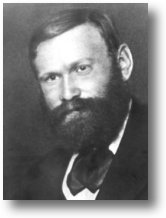By Ryan Koven
It is generally accepted that the telephone, the computer and a host of other technological advances transformed politics, culture, and the world economy over the last century. We laud, indeed worship, great inventors and technological visionaries like Steve Jobs and Alexander Graham Bell -- their genius is manifest in our pockets and on our desks.
We are less conscious of the theoretical work that made recent marvels like telephone networks and the internet possible. In other, harsher words, an innumerate public enjoys a world of gadgets without an understanding or appreciation of the math and science that supports them. While the people that design and market these gadgets may not care if the consumer knows much math, a basic understanding of the mathematics that powers our networked world offers a look at the ways that abstract ideas, conceived with little care for whether they are “useful” or not, can be applied to new inventions and industries. For instance, it’s insightful and somewhat startling to learn that department stores use the same mathematical theory to staff checkout counters as engineers use to ensure the efficiency of telephone networks. It’s time to build some public awareness of the math that powers the modern world. We’ll start with a discussion of a widely applied and eminently “useful” branch of mathematics called queuing theory, and a Danish mathematician that died 83 years ago.
 Whether you have a smartphone or not, no matter if you’re a Mac or a PC, chances are you’ve never heard of Agner Karup Erlang. Erlang studied mathematics at the University of Copenhagen during the last years of the 19th century. After he graduated, in 1901, Erlang deepened his fascination with mathematics during his roughly seven year career as a teacher; he continued to study and publish papers as a member of the Danish Mathematicians’ Association. Through that organization Erlang met John Jensen, the Chief Engineer for the Copenhagen Telephone Company (CTC). Jensen and Erlang became friends, and in 1908 Jensen persuaded Erlang to go to work for the Telephone Company.
Whether you have a smartphone or not, no matter if you’re a Mac or a PC, chances are you’ve never heard of Agner Karup Erlang. Erlang studied mathematics at the University of Copenhagen during the last years of the 19th century. After he graduated, in 1901, Erlang deepened his fascination with mathematics during his roughly seven year career as a teacher; he continued to study and publish papers as a member of the Danish Mathematicians’ Association. Through that organization Erlang met John Jensen, the Chief Engineer for the Copenhagen Telephone Company (CTC). Jensen and Erlang became friends, and in 1908 Jensen persuaded Erlang to go to work for the Telephone Company.
The CTC presented Erlang with a specific, practical problem: find out how many telephone circuits are necessary to ensure that a town receives adequate telephone service. Erlang’s research led to the modern field of Traffic Engineering and the mathematics of queuing theory. Using two formulae Erlang derived in 1917, you can calculate the number of circuits you need to provide an acceptable level of telephone service to a town; or the probability that the next call over a telephone network will be completed; or how long you can expect to wait on hold for the next operator when you call your bank.
Mathematical ideas, and Erlang’s ideas specifically, are remarkable because they are stated in the severe, indifferent language of mathematics, yet they’re often applied to myriad, seemingly unrelated phenomena in the world. Applying the ideas of queuing theory, a store manager at Wal-Mart can tell you how long you can expect to wait in line at the checkout counter at a specific time of day. Using the same ideas, an engineer at Ticketmaster could give you the odds that a computer server will be able to process your browser’s request for the Ticketmaster webpage when tickets for the next Justin Bieber concert are released. It’s this almost unreasonable generality that gives mathematics its power, and it’s one of the reasons that businesses and governments spend billions of dollars a year on basic research.
Erlang’s ideas are powerful-- businesses around the world use them to maximize profit and minimize loss. But you don’t need to be a huge corporation or have a PhD in math to apply queuing theory to your business operations. Even the simplest of Erlang’s formulae can be useful when, for instance, you’re planning an employee schedule for a call center. Let’s say that the average call time for calls to your office is six minutes, and the office averages 20 calls per hour during the afternoon hours. Multiplying the average call time by the call arrival rate gives you the “offered load” in units of erlangs, which is a measure of the number of resources (people answering calls, in this case) that will be tied up during a period of time.
In our example, the offered load of 2 erlangs means that you can expect two of your employees to be on the phone constantly during any given hour in the afternoon.
If you’d like to investigate queuing theory in more detail I suggest a good course in probability and statistics. The intellectual (and monetary) payoff will make it worth your time. But even if you never set foot in a classroom or see another equation for the rest of your life, be aware that you’re never far from math, even when you’re waiting in line to buy cookies and soap.
